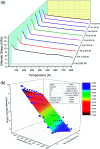A molecular dynamics study on the mechanical properties of Fe-Ni alloy nanowires and their temperature dependence
- PMID: 35520820
- PMCID: PMC9057458
- DOI: 10.1039/d0ra07831j
A molecular dynamics study on the mechanical properties of Fe-Ni alloy nanowires and their temperature dependence
Abstract
Fe-Ni alloy nanowires are widely used in high-density magnetic memories and catalysts due to their unique magnetic and electrochemical properties. Understanding the deformation mechanism and mechanical property of Fe-Ni alloy nanowires is of great importance for the development of devices. However, the detailed deformation mechanism of the alloy nanowires at different temperatures is unclear. Herein, the deformation mechanism of Fe-Ni alloy nanowires and their mechanical properties were investigated via the molecular dynamics simulation method. It was found that the local atomic pressure fluctuation of the Fe-Ni alloy nanowire surface became more prominent with an increase in the Ni content. At low temperature conditions (<50 K), the plastic deformation mechanism of the Fe-Ni alloy nanowires switched from the twinning mechanism to the dislocation slip mechanism with the increase in the Ni content from 0.5 at% to 8.0 at%. In the temperature range of 50-800 K, the dislocation slip mechanism dominated the deformation. Simulation results indicated that there was a significant linear relationship between the Ni content, temperature, and ultimate stress in the temperature range of 50-800 K. Our research revealed the association between the deformation mechanism and temperature in Fe-Ni alloy nanowires, which may facilitate new alloy nanowire designs.
This journal is © The Royal Society of Chemistry.
Conflict of interest statement
There are no conflicts to declare.
Figures







Similar articles
-
The effect of coherent twin boundary migration on the deformation mechanism of Fe-Ni nanowires: molecular dynamics simulation.RSC Adv. 2024 Nov 27;14(51):37886-37894. doi: 10.1039/d4ra07238c. eCollection 2024 Nov 25. RSC Adv. 2024. PMID: 39606282 Free PMC article.
-
Tensile mechanical performance of Ni-Co alloy nanowires by molecular dynamics simulation.RSC Adv. 2019 Aug 19;9(44):25817-25828. doi: 10.1039/c9ra04294f. eCollection 2019 Aug 13. RSC Adv. 2019. PMID: 35530058 Free PMC article.
-
Electron-conduction properties of Fe-Al alloy nanowires.J Phys Chem B. 2008 Dec 11;112(49):15588-95. doi: 10.1021/jp806640u. J Phys Chem B. 2008. PMID: 19367947
-
Effect of Rare Earth Metals (Y, La) and Refractory Metals (Mo, Ta, Re) to Improve the Mechanical Properties of W-Ni-Fe Alloy-A Review.Materials (Basel). 2021 Mar 28;14(7):1660. doi: 10.3390/ma14071660. Materials (Basel). 2021. PMID: 33800669 Free PMC article. Review.
-
Preparation, Deformation Behavior and Irradiation Damage of Refractory Metal Single Crystals for Nuclear Applications: A Review.Materials (Basel). 2024 Jul 10;17(14):3417. doi: 10.3390/ma17143417. Materials (Basel). 2024. PMID: 39063709 Free PMC article. Review.
Cited by
-
The impact of alloying on defect-free nanoparticles exhibiting softer but tougher behavior.Nat Commun. 2021 May 4;12(1):2515. doi: 10.1038/s41467-021-22707-x. Nat Commun. 2021. PMID: 33947860 Free PMC article.
References
-
- Jia Q. Ou X. Langer M. Schreiber B. Grenzer J. Siles P. F. Rodriguez R. D. Huang K. Yuan Y. Heidarian A. Hubner R. You T. G. Yu W. J. Lenz K. Lindner J. Wang X. Facsko S. Nano Res. 2018;11:3519. doi: 10.1007/s12274-017-1793-y. - DOI
-
- Xu C.-L. Li H. Zhao G.-Y. Li H.-L. Mater. Lett. 2006;60:2335. doi: 10.1016/j.matlet.2006.01.052. - DOI
-
- Downey P. R., Flatau A. B., McGary P. D. and Stadler B. J. H., in Sensors and Smart Structures Technologies for Civil, Mechanical, and Aerospace Systems 2008, Pts 1 and 2, ed. M. Tomizuka, 2008, vol. 6932
-
- Park J. J. Reddy K. S. M. Stadler B. Flatau A. IEEE Sens. J. 2017;17:2015.
-
- Downey P. R. and Flatau A. B., in Sensors and Smart Structures Technologies for Civil, Mechanical, and Aerospace Systems 2007, Pts 1 and 2, ed. M. Tomizuka, C. B. Yun and V. Giurgiutiu, 2007, vol. 6529
LinkOut - more resources
Full Text Sources

